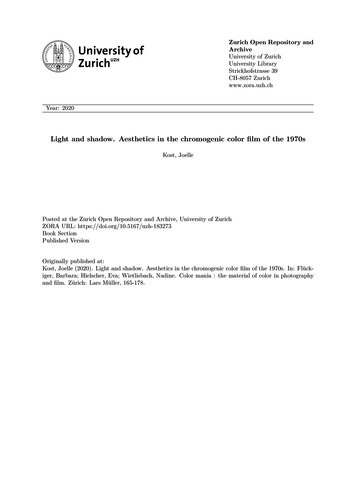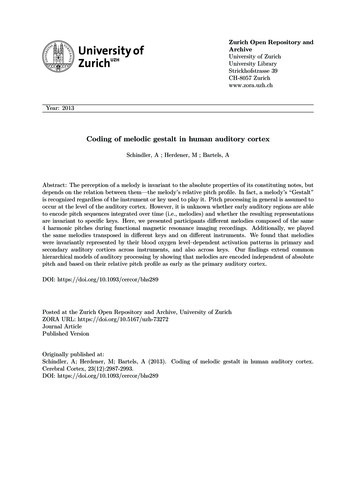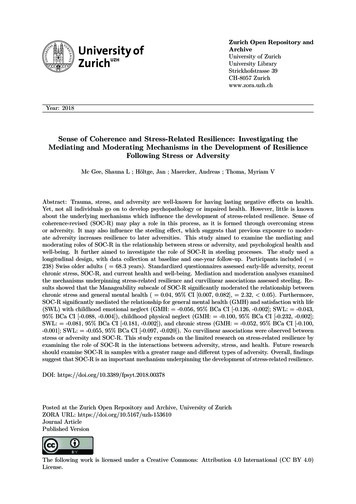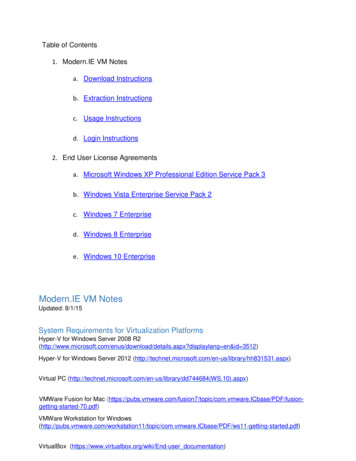
Transcription
Zurich Open Repository andArchiveUniversity of ZurichUniversity LibraryStrickhofstrasse 39CH-8057 Zurichwww.zora.uzh.chYear: 2020Light and shadow. Aesthetics in the chromogenic color film of the 1970sKost, JoellePosted at the Zurich Open Repository and Archive, University of ZurichZORA URL: https://doi.org/10.5167/uzh-183273Book SectionPublished VersionOriginally published at:Kost, Joelle (2020). Light and shadow. Aesthetics in the chromogenic color film of the 1970s. In: Flückiger, Barbara; Hielscher, Eva; Wietlisbach, Nadine. Color mania : the material of color in photographyand film. Zürich: Lars Müller, 165-178.
Light and ShadowAesthetics in the Chromogenic Color Film of the 1970sJoëlle Kost Fig. 1Brooklyn, 1971. The car slowly circles the block, disappearingfrom view, then reappearing. Steam rises through manhole covers; thelighting is sparse. Two detectives are observing the scene. They wait,then make their move. Shaky handheld camera, screaming, flickeringred police lights in the pale night sky. Desaturated, bluish-gray, documentary-like images set the mood. The thriller THE FRENCH CONNECTION(William Friedkin, USA 1971) presents the New York of the 1970s in a rawand unpolished way. It offers an image of its time.American film production of this period is distinguished bygreat changes on the aesthetic, technical, and institutional levels. Formore than twenty years, chromogenic multilayer color film had beenthe leading color film process on the market. 1 Fundamental technicalhurdles had been overcome, and various manufacturers specializingin this process were competing with one another, while its technicalperfection was being constantly advanced. One central concern wasincreasing light sensitivity. Considerable successes had already beenachieved toward the end of the 1960s. In parallel with this, lightingstyles and the self-conception of directors and camera operators werealso changing.Package-Unit System and New HollywoodWith the rise of television in the 1950s, a crisis began in Hollywood. As early as 1948, the Paramount Decree had resulted in the studios separating production and distribution. In its wake, the structureof studios changed greatly. The vertically integrated studio system,whereby the entire conception and distribution of a feature film wereconcentrated in the hands of one studio, was replaced by the “package-unit system”: independent producers put together individual filmprojects, including the screenplay, filming locations, and a qualifiedcrew. Great value was placed on personal style. At the same time, therewas a generational shift among directors. This resulted in new artisticfreedoms and a more decisive engagement with the aesthetics of films.The new generation broke with traditional narrative structures, violatedconventions of genre, and relied on introverted and troubled protag-164165
onists. They also espoused a new realism. Grainy images, desaturatedcolors, lens flares, and natural light were intended to break with theperfection of the previous years. The representatives of the New Hollywood found inspiration in the French Nouvelle Vague, which had transformed the language of film in Europe back in the 1950s and given thedirector the status of an auteur. Figs. 3 4 Fig. 2Changing Lighting StylesAlready in the 1950s, filming locations were occasionallyshifted from the studio to real places. This trend increased over the subsequent decade. Films such as THE FRENCH CONNECTION and THE GODFATHER(Francis Ford Coppola, USA 1972) were shot almost exclusively on location. The cameramen Owen Roizman and Gordon Willis believedit was important that locations not be altered by too much additionallighting. Existing light was usually supplemented only to the extentthe film stock required it—very much in keeping with the slogan “Lessis more,” or, as Willis expressed it, “See what you’re looking at. Don’twalk into a situation and re-manipulate it. Look at it!” 2Especially dark scenes were lit only sparsely. Such low-keylighting had been a familiar schema since the days of silent film, butit changed in the 1970s. Low-key lighting is distinguished by the lack ofa dominant key light; the main lighting is distributed among a few lightsources. Large sections of the image fall into darkness. Whereas in the1950s and 1960s, despite dark lighting design, the background of thescenes could usually be made out and the faces were easily recognizable, in the years that followed more and more sections of the imagewere so weakly lit that no details were visible at all. Deep black surrounded the—often only partially—lit faces. The camera moved evercloser to the protagonists. This phenomenon, which is frequently observed in Technicolor films, now also occurred in chromogenic colorfilms.A reduction of colorfulness can be observed in the use of colored light sources. Into the 1960s, the use of colored light was almostalways diegetically motivated (that is, determined by the narratedworld of the film), used, for example, to underscore certain milieus ortimes of day or as part of the external visualization of the emotionsof characters—also known as mood lighting. 3 The use of both a milieurelated colored light setting and of mood lighting can also be foundprior to the 1970s, but a new phenomenon came into play: an expres-166sive increase in seemingly natural color schemes. In scenes in whichwarm light sources such as candles, fire, or orange artificial light wereemployed, the tonality of the light source in question was used directlyfor the entire scenes. In THE GODFATHER , Willis even chose to use thesewarm tones throughout the film. He used various chocolate-coloredfilters in nuanced ways depending on the venue: broken browns forNew York and intense, gentle shades of brown for Sicily. The work withcolored light sources was adapted to the general use of existing lights.Mixed light situations were integrated directly into the aesthetic ofthe film—for example, when shooting a subway scene in THE FRENCHCONNECTION .Where the use of colored lights is concerned, European filmmakers were in general more experimental than their American col leagues. For example, in IL CONFORMISTA (THE CONFORMIST , Bernardo Berto lucci, ITA 1970) the cameraman Vittorio Storaro made the outdoorscenes at night deep blue, whereas the rest of the film is quite naturalistic. Roizman, by contrast, stuck to pale shades of blue in his nightshots. With his use of strong color, Storaro was taking up a conventionfrom the silent film era that seems out of place in the context of the1970s. The tradition of using shades of blue for night scenes derivedfrom early difficulties with shooting at night and with little light, so thatscenes had to be shot during the day and then colored blue to simulatea nocturnal atmosphere. This motivation no longer existed in Storaro’scase, so his stylistic decision must rather be interpreted as the expression of an individual style, which suited the new self-image of camera operators at the time. Colored light is an especially apt stylisticmeans of individual expression and a way of distinguishing oneselffrom conventions.Technical PillarsThese aesthetic patterns were made possible by, among otherthings, developments to the sensitivity of the film stock. In the late1960s, the sensitivity of 35 mm film increased from 50 to 100 EI (Exposure Index). Eastman Kodak released Eastman Color Negative 5254 in1968, and Fuji Photo Film Co., Ltd., followed a year later with FujicolorNegative, Type 8515. 4 Eastman Kodak had managed to double thesensitivity of its new negative without sacrificing sharpness or color reproduction; accordingly, it was widely accepted on the film market. Thisfilm stock was especially appreciated for its tolerance and reproduction167
of skin tones. For a long time, sensitivity remained at 100 EI; then in theearly 1980s it increased in just a short period by five times to 500 EI.This was due to, among other things, new silver halides, the highly sensitive T-grains that Eastman Kodak first used in its Kodacolor VR 1000Color Film and then implemented a year later in its film stock. In themeantime, filmmakers made use of so-called push processing. The filmstock was deliberately underexposed during filming and then overexposed while being developed in the laboratory. This made it possible to extend the range of lighting, but at the cost of grain size, colorsaturation, and sharpness. These aspects, which at first glance seemlike flaws, were explicitly used for artistic purposes, as THE FRENCH CONNECTION shows.The film stock, the illumination, and the lenses are togetherresponsible for the light control. The urge to increase mobility couldonly be satisfied by developing small, lighter lighting systems. In themid-1970s, moreover, higher-speed lenses were developed that allowed camera operators to open the aperture wider, giving them morelight. Roizman was still filming with an aperture of f2.3, but now twiceas much light was available with apertures of f1.3 to f1.5. Using a special lens of f0.7, Stanley Kubrick even had the opportunity to shootscenes for BARRY LYNDON (GBR 1975) with only candlelight and reflectorson the ceiling—a good example of how the palette of possibilities forfilmmakers was visibly expanding.1.See Barbara Flueckiger’s text in thisvolume, “Film Colors: Materiality, Technique,Aesthetics,” 17–49.2.Gregg Steele, “On Location with TheGodfather,” in American Cinematographer 53,no. 6 (1971): 568–71.3.See Flueckiger, “Film Colors” (see n. 1).New PossibilitiesThis new diversity available to filmmakers of the 1970s—thanksto the interplay of technical innovations, institutional change, and cultural influences—provided the foundation for films like THE FRENCH CONNECTION . A shift away from Hollywood norms made it possible to integrate elements of documentary style into the film. The grainy imagesderive from the director’s personal preference; the desaturated lookcorresponds to the general taste of the 1970s. It was a film that perfectly captured the spirit of the period.1681694.An increase in sensitivity to 100 EI andmore had been achieved in small-format film stockand reversal film as early as the mid-1960s. Becausefilm stocks of the negative-positive process werecentral to professional film production, however, wefocus here on 35 mm film.
Fig. 1THE FRENCH CONNECTION (William Friedkin, USA 1971).Screenshot of the Twentieth Century Fox Home Entertainment DVD,2003170171
Fig. 2THE FRENCH CONNECTION (William Friedkin, USA 1971).Screenshot of the Twentieth Century Fox Home Entertainment DVD,2003172173
Fig. 3Scene from THE GODFATHER (Francis Ford Coppola,USA 1972) set in New York. Technicolor No. V, dye-transfer print, acetatefilm, 35 mm. Credit: Library of Congress. Photo: Joëlle KostFig. 4Scene from THE GODFATHER (Francis Ford Coppola,USA 1972) set in Sicily. Technicolor No. V, dye-transfer print, acetate film,35 mm. Credit: Library of Congress. Photo: Joëlle Kost174175
176
Color Floating in SpaceBarbara Kasten’s Architectural SitesMona Schubert“As I walked into the cool quiet of the interior, swatches of colorfloated in space, changing shape as they landed on surfaces of different textures. These focused planes of colored light radiated out of thebuilding’s irregularly shaped stained-glass apertures, playfully piercingthrough the soft ambient light that emanated from the clerestory.” 1Barbara Kasten, Architectural Sites. Cibachrome prints177–78Architectural Site 19, Pavilion for Japanese Art LACMA,Los Angeles, CA, July 19, 1989, 152.4 127 cm. Credit: Barbara Kasten/Kadel Willborn, Düsseldorf. Architectural Site 17, High Museum of Art,Atlanta, GA, August 29, 1988, 127 152.4 cm.Credit: Barbara Kasten/ Kadel Willborn, Düsseldorf184–85Architectural Site 15, Whitney Museum of American Art,October 19, 1987, 152.4 127 cm. Credit: Barbara Kasten/ PhilaraCollection, Düsseldorf. Architectural Site 10, Museum of ContemporaryArt Los Angeles, December 22, 1986, 152.4 127 cm.Credit: Barbara Kasten/Kadel Willborn, Düsseldorf00The US American artist Barbara Kasten wrote these lines abouther visit to Le Corbusier’s Notre Dame du Haut in Ronchamp, France,which provided an early stimulus to her artistic practice. The interplayof space, colored light, and materiality described so vividly by Kastenforms the starting point and foundation of her oeuvre. Since the 1980s,she has been creating multilayered installations in her Chicago studio,consisting of colored Plexiglas, mirrors, metal, and geometrical forms,which she illuminates from various angles and then photographs. Oneof her key influences is Bauhaus artist László Moholy-Nagy, whose workshe encountered while living in Germany in the 1960s. There are clearparallels between Kasten’s art and the installations of colored materials that Moholy-Nagy photographed in the 1930s. 2 Both focus in stylistic terms on artistic means such as sheen, reflection, projection, andtransparency, as well as spatial illusion amplified by a carefully crafteddistribution of light and shadow.Kasten’s sixteen-part photo series Architectural Sites (1986–1990) can be regarded as an extension of her studio settings. The images were originally commissioned by the US lifestyle magazine VanityFair to accompany an—ultimately unpublished—article discussing financial and cultural centers as the secular cathedrals of our age. Kasten uses the visual tools she had tested out in her studio work—colorprojection and reflection—to produce elaborately staged images oficons of American postmodernist architecture with their opulent foyersand high-ceilinged atria. This shift from the studio into the much largerdimensions of public space necessitated an expansion of the entireproduction setup, coordinated by a team that included everything fromsecurity guards to professional movie lighting technicians. 3 Limited accessibility to the space meant that the photographs of the institutions179
projects, including the screenplay, filming locations, and a qualified crew. Great value was placed on personal style. At the same time, there was a generational shift among directors. This resulted in new artistic freedoms and a more decisive engagement with the aesthetics of films. The new generation broke with traditional narrative .










